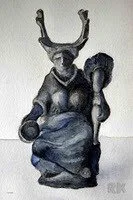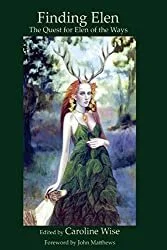The Reindeer Goddess: Saints And Empresses, Antlers And Sovereignty
(Note: As this article is now a few years old, (originally published in 2018) many of the links have sadly broken. Nevertheless I will keep it in its original form – just with the links out. The quotes are originally from my research.)
The beautiful and intriguing, alleged reindeer goddess of ancient British Isles, ‘Elen of the Ways’, needs more investigation. I feel in my heart that there is a horned goddess out there so of course in my scientific brain, I have to find proof enough of her existence that it will satisfy my intuition – my guts.
This intuition told me right away that there is something, something that needs more exploration there. So it’s been fun these past few days, searching out the origins of Elen in history – and running across her in the blogosohere as well.
I found a few references to Marion Zimmer Bradly and The Mists of Avalon series – apparently she wrote in the character of ‘Elein’ in The Priestess of Avalon, who was a priestess of Elen of the Ways. And Elein compared her to the goddess Nehallenia of the Netherlands (perhaps also Celtic), who was goddess of sea ways. She also intertwined her with Elen Luyddogg, the brief Roman empress Welsh saint, ‘Elen of the Hosts’, and St. Helen(a) of Constantinople, also empress of Rome.
As far as I can tell though, this points back to Caroline Wise and her manuscript Elen of the Shimmering Ways, because it was published in 1986. Bradley’s book was published in 2000 and in fact everything I have found that refers to Elen of the Ways, dates later than this original manuscript.
In it Wise says that she has been researching this goddess for 25 years. She in fact named the goddess ‘Elen of the Ways’ after coming to the conclusion that this goddess was one and the same as the Empress ‘Elen of the Hosts’ of Wales, who was responsible for building a network of roads across her territory (more on this in a bit).
This is important because it means that any reference to Elen of the Ways we come to from this point on, points back to Ms. Wise, and we have to go backwards to her, rather than forwards in our search.
In doing so we find it was actually she who decided (through her research) that all of the versions of Elen, Helen and Helena in history were in fact aspects of the same being.
It is she who decides that all notions of a reindeer goddess, across space and time, are one and the same – and who decides that this Elen persona and the reindeer goddess are the same:
Elen is elusive, ethereal, gossamer, yet in my research and experiences over the years, she has allowed me to follow her quicksilver thread and revealed herself in her various guises.
As the Green Lady, she peeps out between the trees in forests and woods. As a British Venus, Goddess of Gardens, she is the Flower Bride: at her Holy wells, mainly to be found in the North of the country, she is guardian of the underground streams that carry the sacred waters. These underground streams have themselves become a metaphor for the secret continuation of sacred wisdom. She is the Guardian of the ancient track ways, the Leys, the kundalini currents in nature, and as the Horned Goddess, she leads us to the first trackways, the migratory tracks of the reindeer and later, she leads us to the path of the red deer through the forests. From here she leads us to the lost Shamanism of the isles of Britain, and we can follow her across Scandinavia, Russia, Mongolia, Siberia, India and beyond.
She has pointed me to ancient London, and to the stars. She has appeared with the fairy folk and she has revealed mysteries of the abstract, magical concept which links sovereignty to the fertility of the land.
My introduction to her came in 1983. I had been working closely with Paul Devereux and the Ley Hunter Magazine, and he gave me a copy of a journal sent to them for review. It was simply titled ‘Helen – Pagan or Christian’. To the contributors, Helena was synonymous with ‘Elen’, and the various ‘Elens’ ‘Elaines’ and Helenas who appear in mythology. They suggested that these figures have become confused and entwined, and include: Elen in the Mabinogion, Helen the Mother of Constantine, a grail barer, a bar maid, and an Essex girl who was daughter of Olde King Cole. My instincts told me that if we could unravel this confusion, instead of seeing a lot of separate characters tangled up together, we would find many faces of the same figure.
Pretty exciting stuff! Until you read this guy’s article (link broken) – which clearly states (and I’ve found this elsewhere) that Elen of the Hosts of Wales lived 60 years or so before St. Helen empress of Rome did – that these two are historical figures. Sure they both had a son name Constantine – and sure their names sound the same and yes they were both sainted and history seems to have mixed them up a bit here an there. But the history is quite certain as to who they married and who their children were – which are completely different stories that ripple down to the present day; St. Helen being the mother of ‘Constantine the Great’ and it looks like all of Wales and a lot of Britain claims ancestral ties to St. Elen, her husband Magnus Maximus and their five children.
If any word could define Elen Luyddog, it would be ancestrix. Her importance lies in the children she bore, whether she and they were real or only mythical is almost unimportant – she and Macsen were significant enough that almost every royal house in Britain wrote pedigrees tracing their lines back to their union. However, for those that claimed this lineage, it was Macsen’s status they wanted to buy into. This fact has passed many people by. It is assumed that Elen is the important figure; she is ‘Celtic’, and she built all those roads, therefore she must have been an important goddess.
Upon reading more, it seems that the antlered Elen was the personal gnosis of Wise and her colleague Cheska Potter – who continually envisioned her during their research, as a deer or as wearing antlers – and made the connection with reindeer:
In 1990, by quite a magical synchronicity, I realised why my friend was seeing a female deer with antlers. The only kind of female deer to have antlers are Reindeer. As I learnt this, things started to tumble into place in my mind at great speed. I could now fix Mascen’s dream of Elen more firmly as ‘Shamanic’ flight, and with the Reindeer as the key, Elen of the Leys led to Shamans further afield. And a colleague from Bulgaria told us shortly after this, that Elen was Bulgarian for Reindeer (I can find no proof of this!). But it seemed significant that not only does the female reindeer have antlers, but she is stronger than the male and does not shed her antlers in winter. It is an older female reindeer that leads the herds.
Both articles referenced above mention the existence of iron age statues of a female deer-woman, with antlers. This I find very interesting in that it proves the existence of the goddess in a prehistorical form.
So the idea seems to be that there was an ancient reindeer or deer goddess (reindeer haven’t been in Britain since the end of the last ice age), the sovereign goddess of Britain even before it was Britain – an ancient forest goddess of the animals. And this idea is mixed in with the stories of the two sainted woman of antiquity, first Elen, which gives us the idea of this goddess being of the “lay ways” or meridians of the earth – a pathfinder – and Helena because her story is similar to Elen’s – mixed in with the mythos of the goddesses of sovereignty, like the Morrigan or Rhiannon.
Goddesses of sovereignty are not a new concept and are prevalent in old Britain and elsewhere. Sovereignty could only be given by Divine right to a king, by the goddess who was the land embodied. Ultimately none could rule without her approval, which was bestowed by way of sex or a marriage contract.
Easy to see St. Elen of Wales in all of this. It was her marriage to Magnus that gave him Britain and which in turn helped him in his conquest of the Roman emperor of the time, enabling him to take the title. It was she who had the roads built throughout her land, between her castles, that enabled his armies to attack and be victorious. An it is she whose names are still on those ancient Roman roads throughout the British Isles – named Sarn Elen or Elen’s Roads.
Roman roads in Britain are often called Sarn Elen, but it is possible that the original Elen’s causeways belong to a much earlier period. Evidence of earlier paving is found under some of the roads, but the straightness of the Roman roads must have impressed the locals. The Celts associated straight paths with magic and the Otherworld, the paths that fairies took from one mound to another, the straight path of a magical spell, and the spirit flight of the shaman. It is significant that Elen is first beheld in a dream, then goes on to build a network of magical roads across Britain. Some associate these with ley lines, the ancient trackways that are said to join together ancient sites, such as tumuli, burial mounds, hillforts, stone circles and so on. It is possible that Elen is the guardian of these, or perhaps she is the guardian of the paths of dreams and visions.
She is certainly a pre-Roman goddess, and possibly much older than the Celts. The first trackways across Britain are said to have been reindeer tracks; Elain is Welsh for deer, and it is possible that Elen is one of the horned goddesses portrayed in Celtic art, such as the two figures found at Lackford and Icklingham. Reindeer are the only deer where the females bear horns, though they died out in Britain at the end of the last Ice Age, so race memories of her must be very ancient indeed. Some of the Sarn Elen tracks are associated with the Wild Hunt, led in some places by the Horned God, and in others by the Death Goddess. Some say that the tracks we call ley lines are spirit paths that the souls of the dead travel to the afterlife. Perhaps she was a psychopomp, guiding wayfarers on unknown paths in this world and the next, or a shamanic deity who guided the spirit flights of witches. Certainly, many people have experienced strange things on the Sarn Elen. The Welsh revered Elen as Elen of the Roads who at Beltane (1st May) opened the season of travel.
from Anna Franklin (link broken)
Easy to see how the two historical figures of Elen and Helen could be mixed up as well – given their similarities… but I’m not sure. It all seems like a bit of a fancy to me. I know how difficult it is to find these ancient gods and goddesses, when we have so little to go on. I appreciate that a lot of our reconstruction comes from personal gnosis, as well as research into history. In this case I’m not totally convinced that Elen and Helen were the same person – and I’m not totally convinced that either are aspects of the ancient antlered goddess. I mean, can’t we have a prayer stone or something with her name on it?
Having said that, I have only just started researching and I certainly haven’t read Ms. Wise’s whole manuscript yet. Can’t even find it!
More from Caer Feddwyd (broken link):
Despite the fact that Elen had never been considered to be a goddess before the late 20th century, and despite the fact that the evidence for her divinity trickles away like water when you examine it closely, it remains true that Someone out there, and possibly more than one Someone, is answering to the name ‘Elen’. This may be the ancestral spirit of Elen Luyddog, or it may be something else altogether. After all, who can guess at the true names of the gods? It is not unlikely that a goddess, perhaps because she likes the offerings being given, or because she is a powerful being in that particular locality, chooses to answer when a name is called.
As a polytheist, I often ask the question: ‘When is a god not a god?’ The boundary between gods, land spirits, ancestral spirits, Little Folk and other entities can be blurred. Now, while Elen Luyddog may not have been a goddess worshipped by the Pre-Christian Britons, I have no problem believing that she could be a powerful ancestral being that has become attached to the roads that she has been associated with for at least eight hundred years, or that another entity interested in these roads has begun answering to the name of Elen.
So I’m not sure of Elen, beyond the statement above – that she could be a very powerful ancestor spirit – and that is pretty cool in and of itself! What I am sure of, is her – the antlered One.
It’s easy to see how the world has been inspired by the enigmatic and tantalizing figure of the horned goddess – goddess of animals and the wild greenwood and of pathways. The story is beautiful and intriguing and desirable! For me this goddess must exist – I feel that she does in some form or another.
So where this leads me is to want to pull apart Elen and the reindeer goddess for a moment, and see what I can find out about the latter, without the entanglement.
Image is Helena of Constantinople by Cima da Conegliano, 1495 (National Gallery of Art, Washington D.C.)




